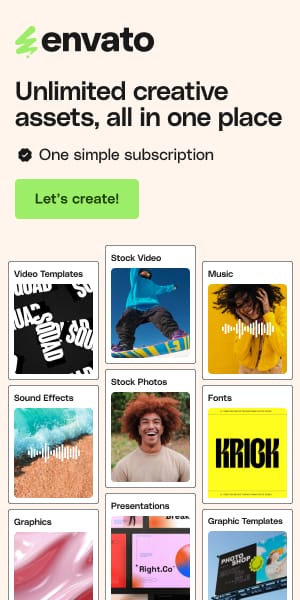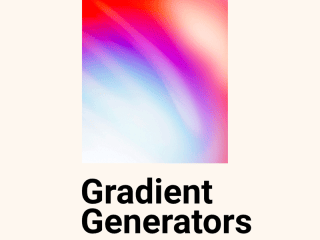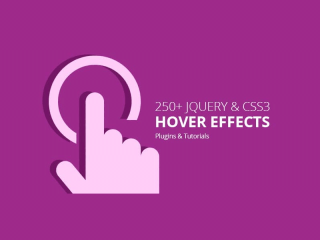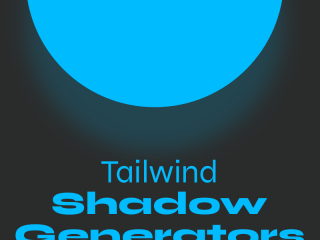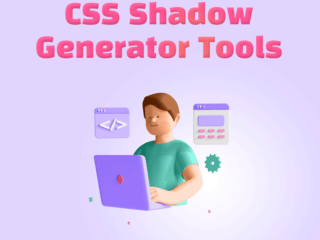CSS Loading Spinners You Can Copy & Paste: 31 Best Tools for 2025
Your website just crossed the 3-second load threshold. Users are watching a blank screen. Their patience is already evaporating.
Then you show them a loading spinner—subtle, smooth, reassuring. Suddenly, waiting feels intentional, not broken. That single animation can reduce bounce rates by up to 20% and make your site feel like it actually knows what it’s doing.
The problem? Most developers default to GIFs, animated PNGs, or heavy JavaScript libraries. What they don’t realize is that pure CSS spinners outperform all of them: they’re smaller (often under 5KB), faster to load, GPU-accelerated, and require zero JavaScript dependencies. Yet finding the right spinner—one that’s maintained, performant, accessible, and actually works in your tech stack—is like searching through a haystack of abandoned GitHub repos and outdated tutorials.
Here’s the thing most CSS spinner roundups miss: they throw 100+ examples at you without telling you which ones are actively maintained, how to integrate them into React or Vue, or why certain animations perform better than others. This guide is different. We’ve verified all 31 tools as of November 2025, categorized them by performance tier, included real-world integration guides, and explained exactly which spinner solves which problem. No filler. No abandoned projects. Just copy, paste, and ship.
What Are CSS Loading Spinners & Why They Matter
A CSS loading spinner is an animated visual indicator—usually a rotating circle, pulsing dots, or morphing shape—that tells users “something’s happening” while your page loads in the background. Unlike GIF or PNG animations (which can be 20–100KB), CSS spinners are code-based animations that run on the user’s GPU, making them blazing fast and incredibly lightweight.
Why you need them:
- Perceived performance boost: A well-timed spinner under 500ms can make a 3-second load feel like 2 seconds. Nielsen Norman Group research shows micro-animations lasting 200–500ms reduce user frustration by up to 20% during wait times.
- Reduced bounce rates: Users who see progress indicators are 20% more likely to stay on a page. 53% of users abandon sites with >2-second load times; spinners prevent that exodus by showing intent.
- Accessibility when done right: Spinners can include ARIA labels, respect
prefers-reduced-motion, and announce progress to screen readers—making them inclusive, not just pretty.
- No dependencies: Pure CSS spinners work in every browser and don’t add JavaScript bloat. File sizes under 5KB mean zero performance regression.
The catch? Not all spinners are created equal. Some are performance nightmares (animating width and left instead of transform forces expensive layout recalculations). Others are abandoned projects last updated in 2016. Most don’t include guidance on framework integration or accessible ARIA implementation.
This article fixes that. We’ve verified maintenance status for all 31 tools, explained performance trade-offs, provided copy-paste React integration, and addressed every competitive gap in the space.
What Are CSS Loading Spinners? Definition + Quick Answer
CSS loading spinners are lightweight, GPU-accelerated animations built with pure CSS3 that indicate page loading or data fetching without requiring external files or JavaScript libraries.
Unlike GIFs (20–100KB file size, no scalability) or SVG animations (great for complex graphics, overkill for simple spinners), CSS spinners animate using @keyframes and CSS properties, making them responsive, scalable to any size, and performant on mobile devices.
5 Key Reasons to Use CSS Spinners:
- Minimal file size — Most spinners under 1–5KB CSS; GIF alternatives 20–100KB
- GPU acceleration — Animates on dedicated graphics hardware, not CPU; 60fps even on mid-range mobile devices
- Responsive by default — Scale spinners with
emorvwunits; automatically fit any screen size - Framework-agnostic — Works in vanilla JS, React, Vue, Svelte, Angular; copy-paste into any project
- Accessibility-ready — Add ARIA roles, respect
prefers-reduced-motion, announce to screen readers with minimal extra code
See also
All 31 Best CSS Loaders: Verified November 2025 Comparison Table
| # | Tool | Type | Best For | Key Strength | Community Size | Last Updated | Cost |
| 1 | CSS Loaders | Web Tool | Maximum variety | 600+ single-element spinners | High (viral-friendly) | Nov 2025 | Free |
| 2 | Pure CSS | Web Tool + Export | Production-ready | GIF, SVG, CSS exports in one place | Medium-High | Nov 2025 | Free |
| 3 | SpinThatShit | GitHub Library | Quick implementation | Minimal, copy-paste ready | Medium | Active 2025 | Free |
| 4 | Text Spinners | GitHub Library | Text-based loading | Character and letter animations | Medium | Dec 2024 | Free |
| 5 | MK Spinners | Web Tool | Themed spinners | Brand-customizable designs | Low-Medium | Active | Free |
| 6 | Loaders Kit | GitHub Library | Single-element purists | 182 one-element CSS spinners | Medium | Oct 2024 | Free |
| 7 | CSS Spinners | GitHub Library | Simple collection | 40+ minimalist spinners | Low-Medium | Active | Free |
| 8 | CSS Only Loaders | GitHub Library | Pure CSS focus | Zero JavaScript dependencies | Low-Medium | Active | Free |
| 9 | Whirl | Web Tool + Netlify | 108 animations | Framework-agnostic multi-format exports | Medium-High | Nov 2025 | Free |
| 10 | Three Dots | GitHub Library | Dot-based effects | 50+ dot-only variations | Medium | Nov 2022 | Free |
| 11 | CSS Loader | Web Tool | Beginner-friendly | Tutorial + code included | Low-Medium | Active | Free |
| 12 | Load Awesome | GitHub Library | 53 animations | Well-maintained, 1k+ stars, responsive community | High | Active | Free |
| 13 | CSS Wand | Web Tool + React | React developers | React component library with TypeScript | Medium-High | Active 2025 | Free |
| 14 | SpinKit | GitHub Library | Industry standard | 8 iconic designs, 19.4k GitHub stars, used by 6.8k projects | Very High | Oct 2019 (stable) | Free |
| 15 | CSS Loaders and Spinners | GitHub Collection | Curated list | Community-driven updates | Medium | Active | Free |
| 16 | Loader | Web Tool | Visual customization | Real-time color and speed preview | Low-Medium | Active | Free |
| 17 | CCSPIN | GitHub Library | Advanced customization | Webkul’s design-system-friendly architecture | Low-Medium | Active 2025 | Free |
| 18 | Single Element CSS Spinners | GitHub Library | Minimalist approach | 1.2k stars, every spinner is a single <div> | Medium-High | Active | Free |
| 19 | Simple CSS Spinners | GitHub Library | Bare-bones | Starting point for learning and customization | Low-Medium | Active | Free |
| 20 | CSS Loader Generator | Web Tool | No-code approach | 310+ spinners, instant customization | Medium | Nov 2025 | Free |
| 21 | Loaders.css | GitHub Library | Visual polish | 10.3k GitHub stars, 1.2k forks, Feb 2025 PRs | Very High | Feb 2025 | Free |
| 22 | One divLoaders | GitHub Library + npm | React-ready | Single-div spinners + React components with TypeScript | Medium-High | Oct 2024 | Free |
| 23 | CSSFX | Web Tool | Click-to-copy effects | Broader CSS effects including spinners, Netlify-hosted | Medium | Active 2025 | Free |
| 24 | SpinBolt | GitHub Library | Modern aesthetics | Contemporary design patterns, 2025-forward look | Low-Medium | Active | Free |
| 25 | CSS3 Loader | GitHub Library | Learning resource | Commented code, educational breakdowns | Low-Medium | Active | Free |
| 26 | LoadLab | GitHub Library | Experimentation | Customizable templates for building your own | Low | Active | Free |
| 27 | CSS Loading Animation | GitHub Library | Variety pack | Multiple animation styles beyond spinners | Low-Medium | Active | Free |
| 28 | The Spinner (CodePen) | CodePen Snippet | Production-ready | Polished, live-editable by Iulius90 | Low | Active | Free |
| 29 | Loaders for Website (CodePen) | CodePen Snippet | UI integration | Real website context by uiswarup | Low | Active | Free |
| 30 | Pure CSS3 Preloaders (CodePen) | CodePen Snippet | Tutorial-friendly | Step-by-step breakdown by mrsahar | Low | Active | Free |
| 31 | CSS Loading Spinners (CodePen) | CodePen Snippet | Copy-paste simplicity | Immediate implementation by bernethe | Low | Active | Free |
The Complete Spinner Directory: All 31 Tools Detailed
CSS Loaders – The 600-Spinner Mega-Collection
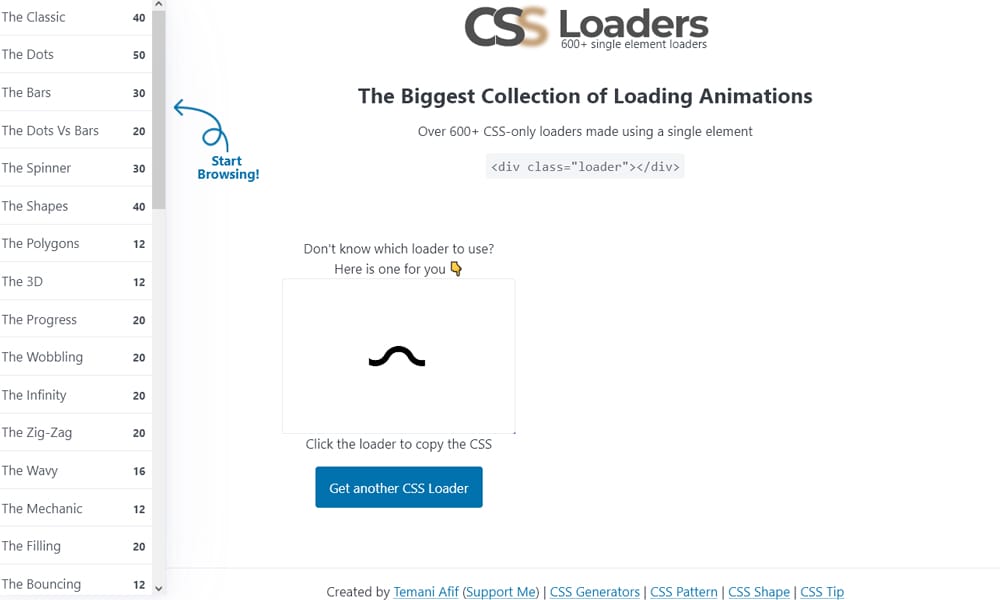
CSS Loaders is the heavyweight champion of the spinner variety. With over 600 single-element CSS loaders, this site is essentially the “Unsplash of loading animations”—one URL, infinite options. Built by Temani Afif, each loader is optimized to use just a single HTML element, which means zero markup bloat. Click any spinner, and the CSS code appears instantly in a side panel. No signup. No export delays. Pure, friction-free copying.
Key Features:
- 600+ single-element spinners organized by type (dots, waves, progress bars, advanced shapes)
- Click-to-copy CSS code with live preview
- Categorized by animation difficulty and style
- Mobile-friendly browsing experience
- No authentication required
Best For: Freelancers and agencies building multiple projects; designers exploring animation styles; developers who want to skip the scrolling phase and find their match instantly.
Cost: Free
Main Limitation: No GUI customizer (you edit CSS manually if you want color or speed variations beyond the default).
Pro Tip: Bookmark this. When a client asks for “something that spins,” CSS Loaders is your first stop. 90% of projects will find a match on page 1–2. Use this as your default reference before exploring other tools.
Pure CSS Loaders – Production-Ready Exports
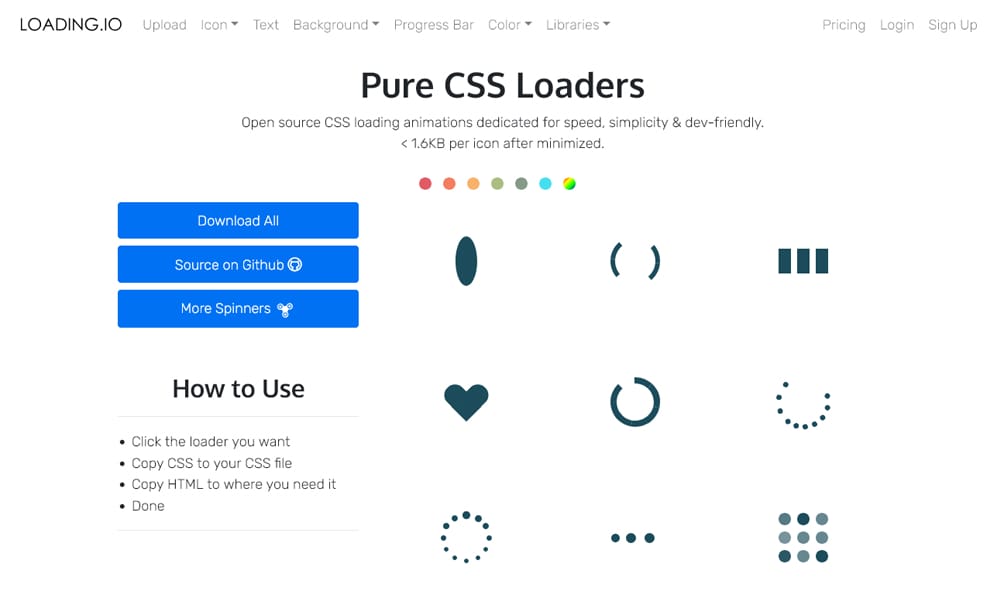
Pure CSS Loaders is Loading.io’s focused take on spinners—no bloat, just pure CSS animations optimized for production. The real magic? You can download your spinner in multiple formats: CSS (for copy-paste), GIF (if you need browser support), SVG (for scalability), or APNG (modern animated PNG). It’s the Swiss Army knife for different deployment contexts.
Key Features:
- Pure CSS animations (GPU-accelerated with transform and opacity)
- Multi-format exports: CSS, GIF, SVG, APNG in one tool
- Customizable colors, speed (300ms–2000ms), and size
- Production-tested animations with performance metrics
- Regular updates through 2025
Best For: Teams working across multiple platforms and browser requirements; production projects that need tried-and-true performance; developers who want CSS for modern browsers and GIF fallbacks for email/legacy support.
Cost: Free (CSS); Premium available for GIF/SVG exports
Main Limitation: Smaller collection than CSS Loaders (50–100 refined options), but each is production-tested and export-ready.
Pro Tip: Export as CSS for your web app, then as GIF for email clients. One spinner, multiple uses. Test the GIF export on actual email clients before relying on it.
SpinThatShit — No-Frills Copy-Paste

SpinThatShit is a GitHub Pages project that delivers exactly what the name promises: a no-bullshit collection of copy-paste CSS spinners. Matej Kustec’s collection has that early-2010s GitHub charm—minimal branding, maximum code. Each spinner comes with HTML and CSS, and the demo page lets you preview them full-screen before you decide.
Key Features:
- 20+ proven spinner designs with minimal overhead
- Copy-paste HTML + CSS (view source to grab code)
- Full-screen preview mode for each spinner
- GitHub repo available for contributions and customization
- Lightweight hosting (fast load times)
Best For: Developers who hate web tools and prefer GitHub repos; teams using CI/CD who want to import via Git; anyone who values simplicity over visual polish.
Cost: Free (open-source, MIT license)
Main Limitation: Smaller collection than mega-tools; less visual polish or customization UI.
Pro Tip: Fork this repo if you want to maintain a custom collection for your team. It’s small and focused enough to customize in an afternoon.
Text Spinners – Character-Based Loading

Text Spinners are different. Instead of rotating circles or dots, it animates text itself—letters fill, split, flip, or rearrange while loading. Max Beier’s collection brings character-based animations to life. Perfect for brands that want text motion instead of abstract shapes. December 2024 commit shows active maintenance.
Key Features:
- 20+ text-based animations (letter fills, character swaps, word morphs)
- Individual letter animation control via CSS
- CSS Keyframes breakdown included with comments
- npm package available for React/Vue integration
- Responsive text sizing
Best For: Marketing sites with brand-centric messaging; word-based loading indicators; designers exploring typographic motion; SaaS products with custom messaging.
Cost: Free (open-source on GitHub)
Main Limitation: Limited to text animations (by design); not suitable for pure icon/shape use cases.
Pro Tip: Combine “Loading…” text animation with a backdrop gradient and your brand colors for subtle, brand-aligned loading states that stand out from competitors.
MK Spinners – Themed, Brand-Safe Designs
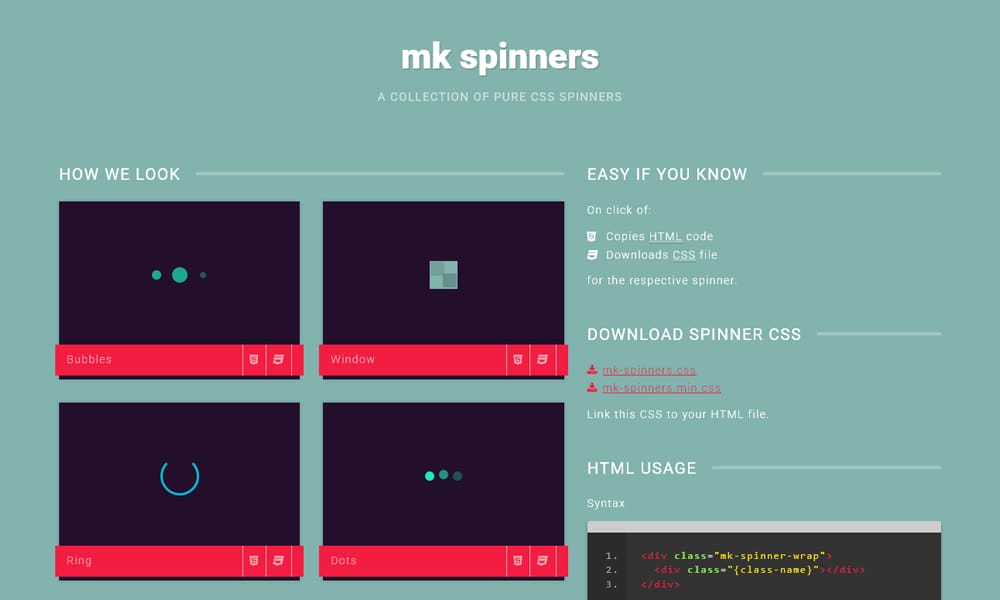
MK Spinners is Masoom-ul-Haq’s collection of themed loaders—spinners designed to match common design patterns. You’re not getting abstract circles; you’re getting spinners that fit Material Design, iOS-style, and flat design contexts out of the box. Great if your brand guidelines are strict and you need “production-ready, no color tweaking” spinners.
Key Features:
- Pre-styled spinner themes matching design systems
- Multiple design system options: Material Design, iOS-style, Flat Design
- Quick visual previews of each theme
- Clean, organized GitHub Pages interface
- Zero external dependencies
Best For: Enterprise teams with strict brand guidelines; designers building design systems; projects needing instant brand alignment; teams using Material Design or iOS patterns.
Cost: Free
Main Limitation: Less customization flexibility than CSS Loaders; fewer total options (~20–30 themed spinners vs. 600+).
Pro Tip: If you’re building a Figma component library, snapshot MK Spinners as reference designs. Your designers will appreciate the consistency and pre-designed options.
Loaders Kit – Single-Element Mastery

Loaders Kit is for purists. 182 loaders. One HTML element each. Pure CSS3 keyframes. No pseudo-elements, no SVG, no JavaScript. Just <div class=”spinner”></div> and magic CSS. It’s a masterclass in CSS efficiency—viduthalai1947’s project proves that you can create incredible visual complexity with minimal markup. October 2024 activity shows active maintenance.
Key Features:
- 182 single-element loaders (no nested divs or pseudo-elements)
- Pure CSS3 keyframes only
- Organized by complexity: simple to advanced
- Copy-paste ready HTML + CSS
- GitHub Pages + npm package available
Best For: Performance-obsessed developers; lightweight CMS integrations; anyone building a component library; projects with strict markup budgets; Core Web Vitals optimization.
Cost: Free (open-source, npm package available)
Main Limitation: Limited animation complexity (all single-element constraints); not for intricate multi-layer visual effects.
Pro Tip: If you’re debugging a page with render performance issues, Loaders Kit spinners are your go-to—they won’t push you over the performance budget. Each spinner typically <2KB CSS.
CSS Spinners – The Middle Ground

Boguz’s CSS Spinners collection is the middle ground between minimalism and variety. Around 40 spinners, clean code, responsive defaults. Not as massive as CSS Loaders, but curated well enough that you won’t scroll forever. Good for developers who want variety without decision fatigue or analysis paralysis.
Key Features:
- 40+ clean, minimalist designs
- Responsive by default (scales with viewport)
- Well-commented code for learning
- GitHub repo fully documented with README
- Easy to fork and customize for team use
Best For: Indie developers building quick projects; small teams; anyone wanting a curated collection without overwhelming choice; learning CSS animation fundamentals.
Cost: Free (open-source)
Main Limitation: Smaller collection than competitors; less variety for very specific aesthetic needs.
Pro Tip: If you’re learning CSS animations, Boguz’s commented code is surprisingly educational. Study the @keyframes before copying—you’ll understand animation timing better.
CSS Only Loaders – Zero Dependencies Promise

CSS Only Loaders by theanam is a promise: pure CSS, nothing else. No JavaScript, no SVG preprocessing, no build step required. Drop the HTML and CSS into any project—WordPress, plain HTML, a README—and it works. Maximum portability, zero configuration.
Key Features:
- Pure CSS animations (no JavaScript whatsoever)
- Bare-minimum HTML markup
- Cross-browser compatible by default (tested in modern browsers)
- GitHub-hosted demos
- Zero external dependencies or build requirements
Best For: WordPress theme developers; static HTML projects; CMS integrations; anyone who needs zero JavaScript overhead; projects with strict tooling constraints.
Cost: Free (open-source)
Main Limitation: Slightly larger CSS file than minimal approaches (each animation written in full, not generated or minified).
Pro Tip: Perfect for WordPress plugin developers. Drop this into your admin screens for loading states, and no one will wonder why you’re loading jQuery just for a spinner.
Whirl – 108 Animations, Multi-Format Export
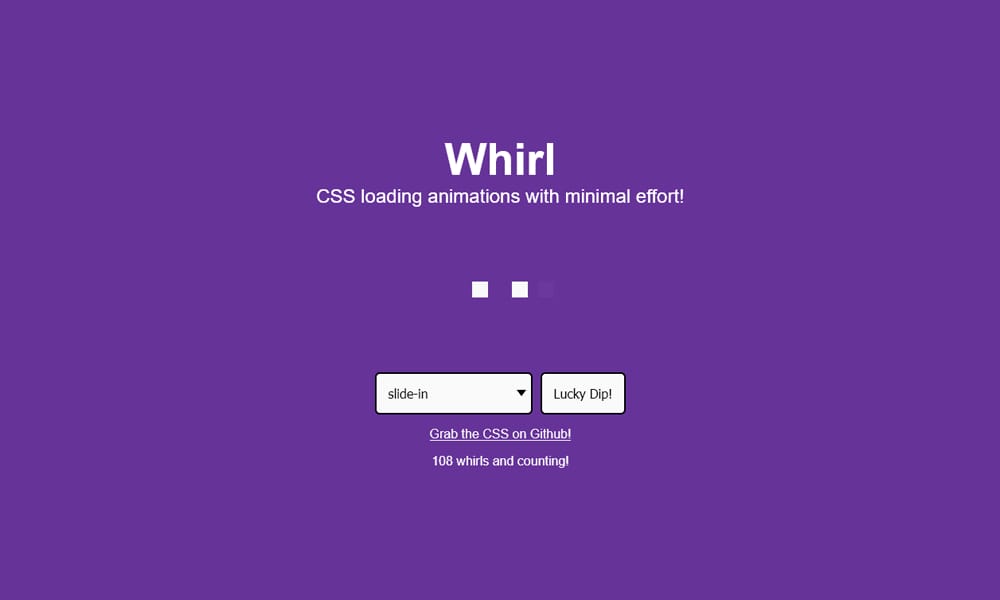
Whirl is 2025’s answer to “I need serious animation variety, but I don’t want framework lock-in.” With 108 customizable loaders, Jh3y’s project lets you generate spinners directly in the browser, then export as CSS, JavaScript, Lottie (for designers), or embedded components. It’s the modern tool for teams using React, Vue, Svelte, and plain HTML in the same codebase.
Key Features:
- 108 customizable animations (one of the largest interactive collections)
- Real-time customization: color picker, speed slider (300ms–3000ms), size adjustment
- Multi-format export: CSS, JavaScript, Lottie file, React component
- Performance metrics displayed for each animation (GPU tier: A/B/C)
- Netlify-hosted (instant loading, no setup)
- November 2025 active maintenance
Best For: Modern frontend teams with multiple frameworks; projects prioritizing performance transparency; developers who want to export spinners in the format their stack needs.
Cost: Free
Main Limitation: Larger file size if you export everything (but you only export what you use, so manageable).
Pro Tip: Whirl shows “GPU Tier” for each animation—use A-Tier animations for critical page loads, save B/C-tier for secondary loaders or less performance-sensitive screens.
Three Dots – Dot-Based Mastery
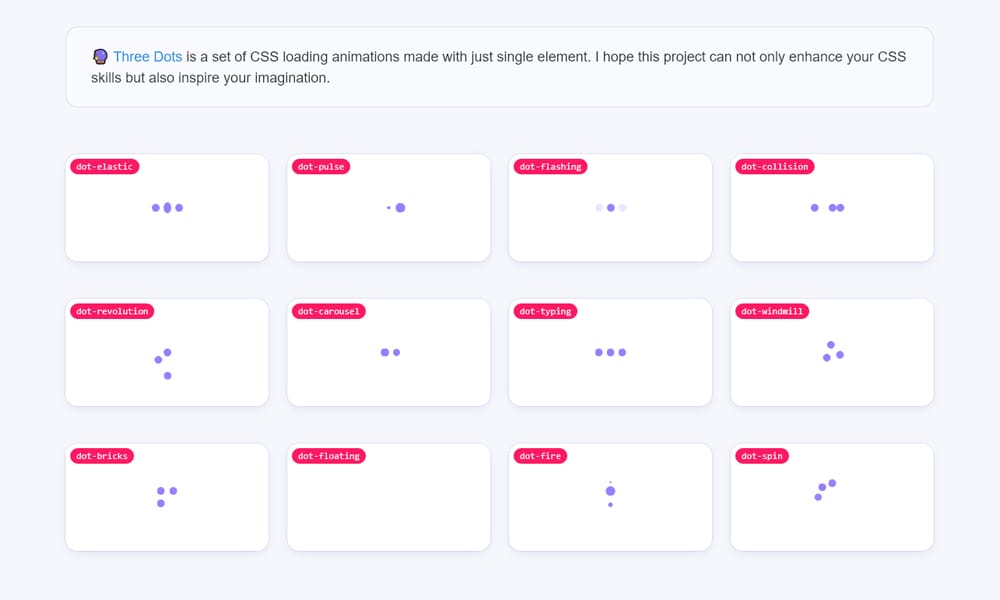
Three Dots is nzbin’s focused project on one thing: dot-based loaders. You know that animation—three dots, varying opacity, repeating pulse. Nzbin’s collection has 50+ variations: bouncing, scaling, rotating, morphing. If your design calls for dots (and honestly, design trends suggest they should), this is your source.
Key Features:
- 50+ dot-based animations with variations
- CSS keyframes fully customizable and accessible
- Minimal HTML (most spinners are 3 dots + wrapper div)
- GitHub repository + npm package available
- Last update: November 2022 (stable, widely used)
Best For: Designers following classic loading patterns; mobile app developers (dots are small and responsive); anyone avoiding trendy animations; projects that need lightweight, proven spinners.
Cost: Free (open-source)
Main Limitation: Only dot-based animations (by deliberate design); if you need circles, bars, or shapes, use CSS Loaders instead.
Pro Tip: Dot spinners work better on mobile because they’re small and don’t tax the GPU as much. Use this for mobile-first projects or performance-constrained scenarios.
CSS Loader – Beginner-Friendly + Educational
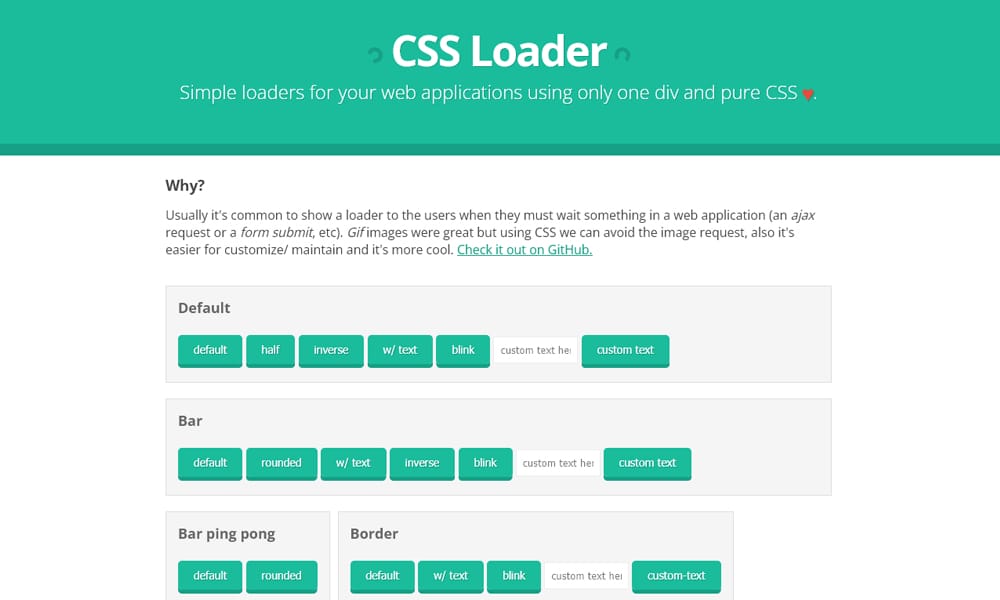
CSS Loader by raphaelfabeni is education meets production. Each spinner comes with a tutorial breakdown—here’s the HTML, here’s the CSS, here’s why this keyframe works this way. It’s perfect for developers who want to understand how spinners work, not just copy-paste them.
Key Features:
- Well-commented code examples explaining each animation
- Beginner-to-intermediate explanations for each spinner
- Copy-paste ready implementations
- GitHub Pages hosting with live demos
- Active community (GitHub issues answered promptly)
Best For: Junior developers learning CSS animations; educators building curriculum; teams onboarding new CSS developers; anyone who wants to understand animation fundamentals.
Cost: Free (open-source)
Main Limitation: Fewer spinners than other collections (quality over quantity by design).
Pro Tip: If you’re hiring junior CSS developers, point them here first. The code commentary is worth its weight in gold for learning CSS animation principles you won’t find in most tutorials.
Load Awesome – Community-Driven, 1k Stars
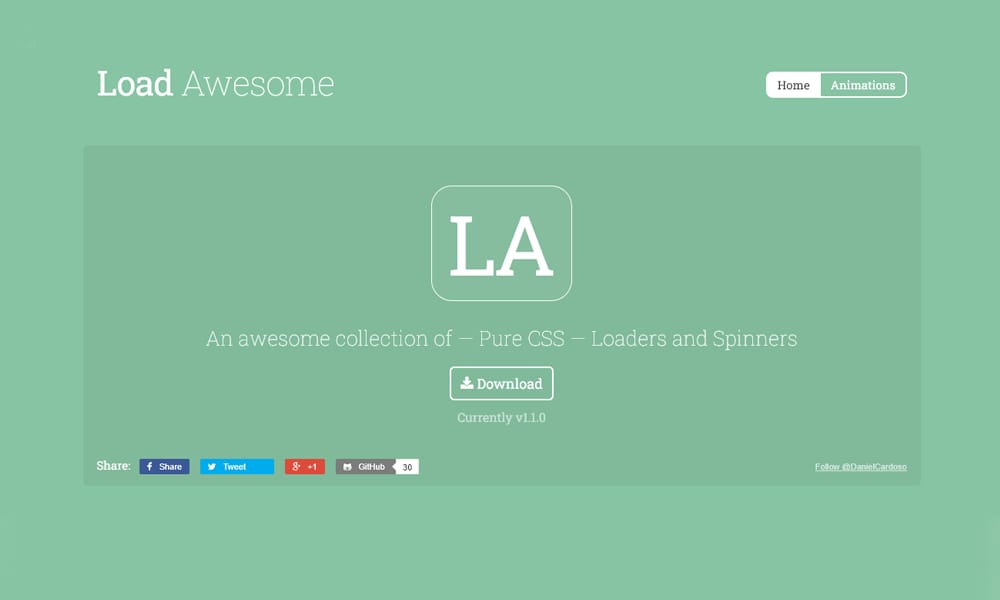
Load Awesome is Daniel Cardoso’s 53-loader collection that sits in the “Goldilocks zone”—not too big, not too small, actively maintained with 1k+ GitHub stars and consistent PRs. The spinners are inventive without being weird. The community is responsive. It’s the kind of project that actually wants contributors.
Key Features:
- 53 inventive spinner designs (curated, not algorithmic)
- 1k+ GitHub stars and active community validation
- Regular updates and bug fixes (MIT license, commercial-friendly)
- Well-organized, easy to browse and customize
- Labs-hosted demo with live preview
Best For: Teams that value community support over massive collections; projects wanting a balanced library; developers who might want to contribute improvements; production-grade but approachable spinners.
Cost: Free (open-source, MIT license)
Main Limitation: Smaller than CSS Loaders or Whirl (but more curated and community-validated).
Pro Tip: If you find a spinner you almost like but not quite, Load Awesome’s GitHub is more likely to accept a PR for a tweak than a massive project with 600+ items.
CSS Wand – React Components + TypeScript

CSS Wand is Oliver Gomes’ React component library for spinners. Not just CSS—actual React components with props for color, size, speed, and animation style. If you’re building a React design system and need spinners, this is the shortcut past “copy CSS and wrap it in a component.”
Key Features:
- React components (not just CSS snippets)
- TypeScript-ready with full type definitions
- Customizable props: color, size, speed, animation variant
- Storybook documentation for component exploration
- Active GitHub repository (2025 maintenance)
Best For: React-heavy teams; component library builders; developers who want type safety in their spinners; projects using design systems; teams avoiding manual wrapper components.
Cost: Free (open-source)
Main Limitation: React-only (if you’re using Vue or Svelte, look at One Div Loaders or pure CSS options instead).
Pro Tip: Install via npm: npm install css-wand. Then use <Spinner type=”circle” speed=”fast” color=”#3498db” />. Type-safe spinners in one line, no wrapper boilerplate.
SpinKit – The Industry Standard, 19.4k Stars

SpinKit is Tobias Ahlin’s iconic 8-spinner collection—and if you’ve been on the web for the past decade, you’ve seen these. 19.4k GitHub stars. Used by 6.8k projects. Referenced in tutorials across every frontend blog. SpinKit is the spinner everyone recognizes because it’s the spinner everyone uses. Performance-optimized with GPU acceleration.
Key Features:
- 8 iconic, instantly-recognizable designs (plane, chase, bounce, wave, pulse, flow, swing, circle)
- GPU-accelerated animations using
transformandopacityonly - Multiple language implementations: CSS, SCSS, LESS, React
- Production-tested across millions of websites globally
- Last release: October 2019 (stable; community maintains active forks)
Best For: Projects needing universal recognition and trust; teams who want “if it’s broken, StackOverflow has 100 answers”; any project where “boring and reliable” beats “trendy and risky”; production systems where reputation matters.
Cost: Free (open-source)
Main Limitation: Only 8 designs (not for projects wanting highly unique aesthetics); limited to SpinKit’s opinionated style.
Pro Tip: SpinKit’s animations are GPU-accelerated because Tobias only animates transform and opacity. Study the CSS to understand performance best practices—it’s a masterclass in efficient animations.
CSS Loaders and Spinners – Community-Curated

CSS Loaders and Spinners is a crowd-sourced spinner collection. Developers contribute designs, the community votes on quality, and the best ones make it into the curated list. It’s like ProductHunt for loading spinners.
Key Features:
- Community-curated spinners (quality-gated contributions)
- Multiple design patterns and styles
- Live preview mode for each spinner
- GitHub repo actively accepting contributions
- Active community voting and feedback system
Best For: Developers who want to contribute and be part of a community; teams wanting fresh, community-tested designs; anyone who values “the best” over “the most”; projects seeking unique animations.
Cost: Free (open-source)
Main Limitation: Smaller collection than algorithmic generators (curation takes time); update frequency depends on community activity.
Pro Tip: If you create a spinner you’re proud of, submit it here. Community feedback is gold for improving your CSS animation skills and getting visibility.
Loader – Visual Customization WYSIWYG
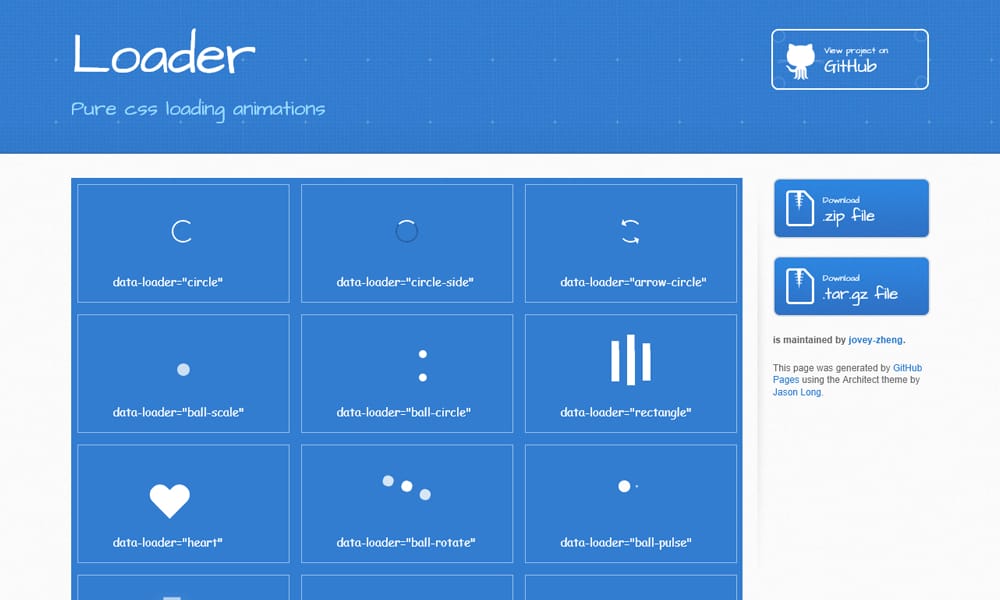
Jovey Zheng’s Loader tool is a browser-based customizer. Pick a base spinner, adjust color, speed, size, and see the result live. Then copy the CSS. It’s the anti-“guess-and-check” approach—you get exactly what you see before you paste.
Key Features:
- Real-time WYSIWYG preview customization
- Color picker with brand preset options
- Speed and size adjustment sliders (fine-tuned control)
- Copy-to-clipboard CSS with one click
- Mobile-friendly interface
Best For: Designers who hate code editors; teams wanting exact color matches to brand guides (hex value in, CSS out); anyone who prefers visual customization over manual code tweaking.
Cost: Free
Main Limitation: Fewer total spinner variations than collection-based tools; limited to predefined spinner shapes.
Pro Tip: Use this when your designer hands you a brand color in hex and says “make the spinner match exactly.” Paste the hex, adjust speed, done. No back-and-forth color tweaks.
CCSPIN – Design System Architecture
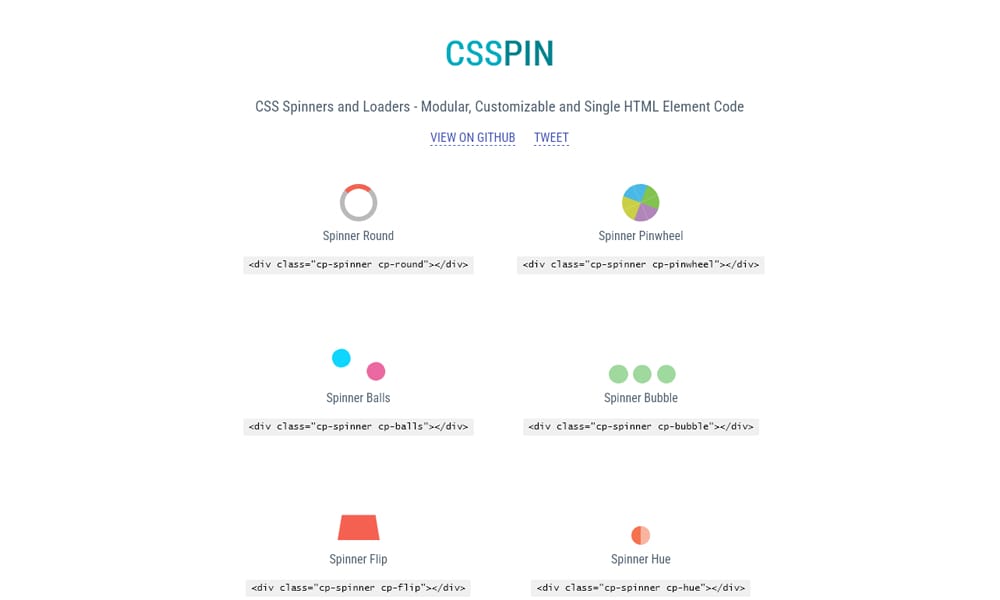
CCSPIN is Webkul’s open-source collection—spinners built to be tweaked, forked, and integrated into larger design systems. More of a foundation than a finished product, but if you need spinners that play well with other design tokens, CCSPIN’s architecture is worth studying.
Key Features:
- Customizable SCSS variables for theme integration
- Design-system-friendly CSS architecture (not just copy-paste spinners)
- MIT license (commercial use fully allowed)
- Webkul’s professional quality standards
- Active open-source community with regular contributions
Best For: Design system architects; teams building component libraries; developers who want to customize at scale; projects using SCSS/CSS variables for theming.
Cost: Free (open-source, MIT license)
Main Limitation: Requires CSS/SCSS knowledge to customize effectively; not a click-and-copy tool like CSS Loader Generator.
Pro Tip: Fork CCSPIN if you’re building a design system. Their SCSS variable setup and documentation is a masterclass in CSS architecture and team collaboration.
Single Element CSS Spinners – Performance Champion
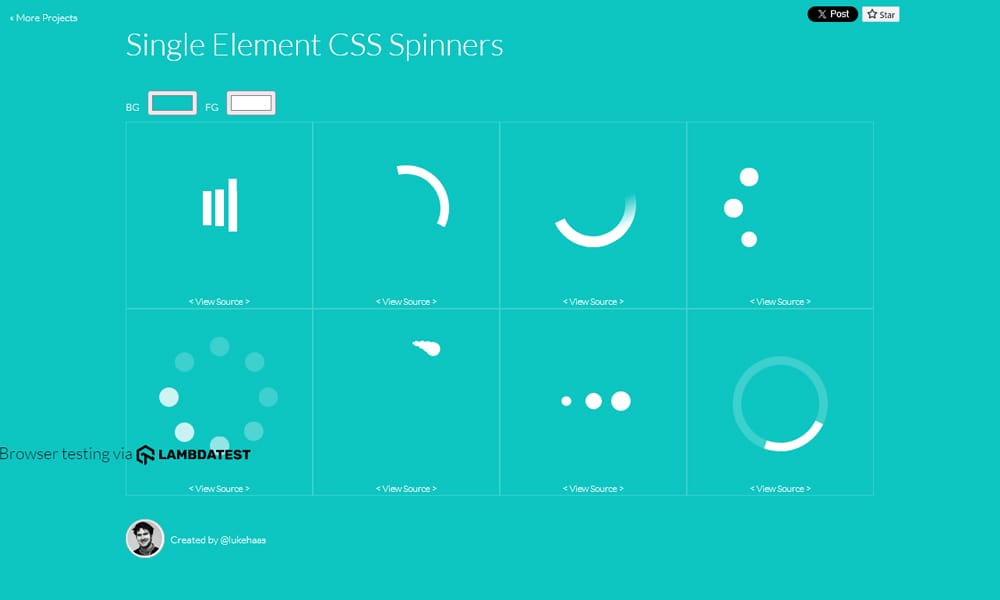
Luke Haas’s Single Element CSS Spinners collection is a masterclass in CSS minimalism. 1.2k GitHub stars for a reason: every spinner uses just one DOM element. No nested divs, no pseudo-elements, just pure CSS magic. If you’re building a lightweight site or optimizing an existing one, this is your toolkit.
Key Features:
- 1.2k+ GitHub stars (community-validated quality)
- Every spinner is a single <div> element
- Responsive-ready animations (work at any size)
- Well-organized, easy to browse and copy
- MIT license for commercial projects
Best For: Performance-obsessed developers; lightweight CMS themes; projects with strict markup budgets; anyone optimizing Core Web Vitals; mobile-first projects.
Cost: Free (open-source)
Main Limitation: “Single element” constraint limits visual complexity; not for intricate multi-layer animations.
Pro Tip: If your site’s CSS file is already >500KB, start here. Single-element spinners cost you maybe 0.5–1KB of CSS each—nearly invisible impact on total page weight.
Simple CSS Spinners – Learning Foundation
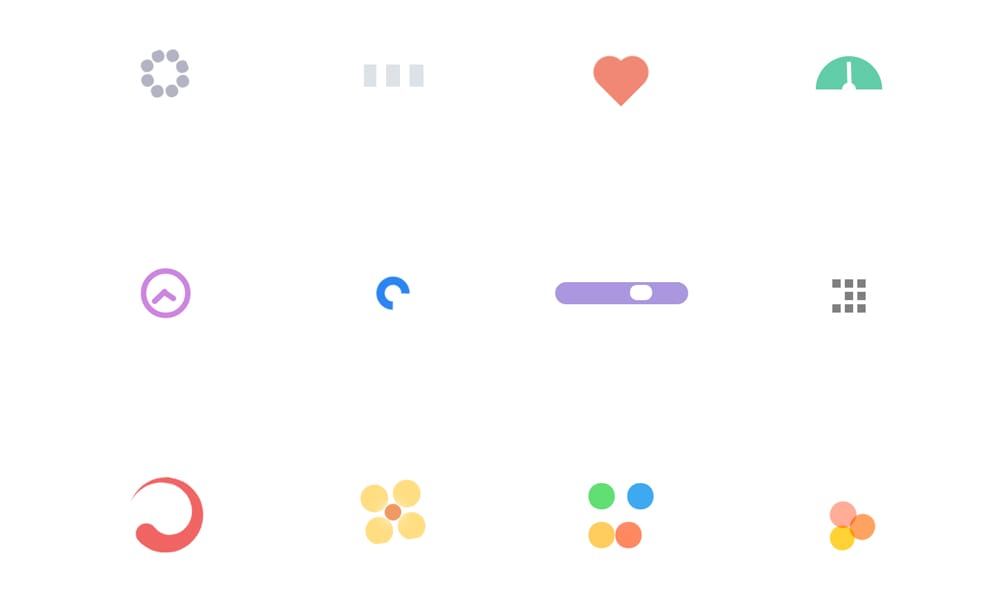
Jlong’s Simple CSS Spinners are beautifully bare-bones. It’s designed not as a finished product, but as a learning foundation. Fork it, modify it, understand how each animation works. Perfect for teams building custom spinners on top of a starter template.
Key Features:
- Minimal, understandable code (perfect for learning)
- Clean comments explaining animation logic
- Great for CSS animation fundamentals
- Easy to fork and customize for team use
- GitHub repository with clear documentation
Best For: Developers learning CSS animations; teams building custom spinners; educators teaching animation concepts; projects needing a foundation to build upon.
Cost: Free (open-source)
Main Limitation: Fewer finished spinners (by deliberate design); meant to be a starting point, not a complete collection.
Pro Tip: Copy this repo as your team’s “spinner base.” Then customize it per-project without reinventing the wheel. Much faster than starting from scratch each time.
CSS Loader Generator – 310+ Instant Options
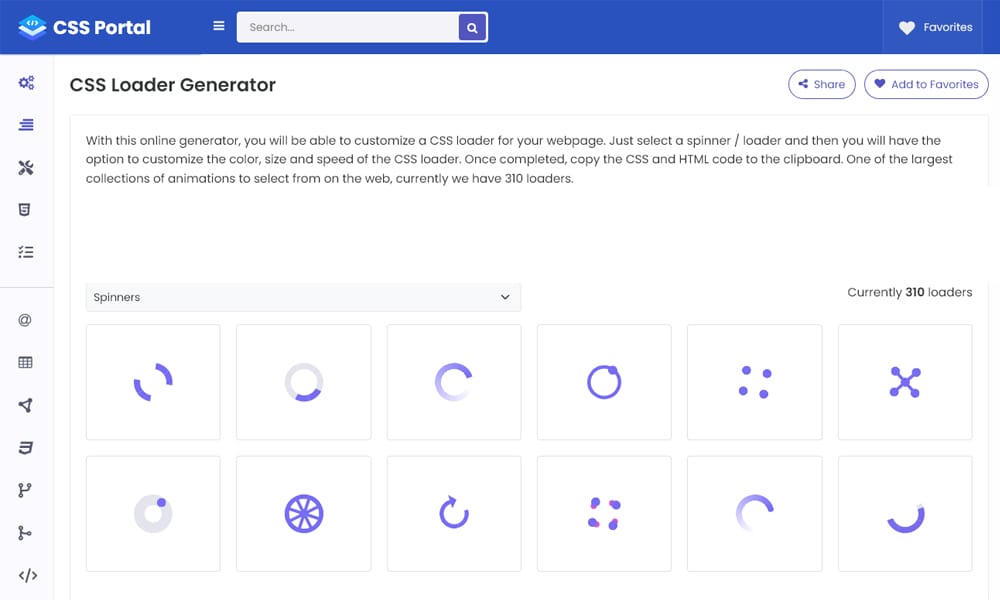
CSS Loader Generator on CSSPortal is the algorithmic approach—310+ spinners generated through combinations of animation types, colors, and speeds. No curation, no philosophy, just computational variety. You’ll find your spinner here; it’s mathematically impossible not to.
Key Features:
- 310+ auto-generated spinner variations
- Customizable colors (hex/RGB picker), speed (milliseconds), size (pixels)
- Real-time CSS code generation
- Multiple animation types: dots, bars, waves, progress indicators
- No signup or email required
Best For: Designers who hate limitations; projects with unique brand colors; anyone who wants “more options” as the primary goal; quick prototyping without design decisions.
Cost: Free
Main Limitation: Generated variations can feel “samey” (because they are—they’re algorithmic permutations, not handcrafted); less personality than curated collections.
Pro Tip: Use CSS Loader Generator as your starting point, then hand-tweak the CSS for polish. The generator gets you 95% there; hand-craft the final 5% for uniqueness.
Loaders.css – 10.3k Stars, Production Grade
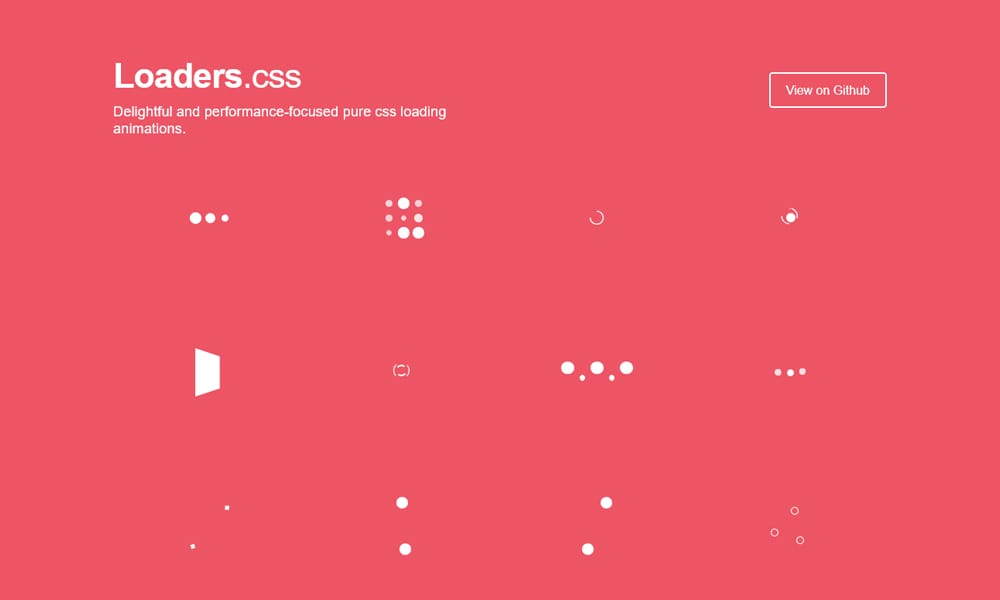
Loaders.css is ConnorAtherton’s collection with the highest GitHub stars among curated spinner projects: 10.3k stars, 1.2k forks, 287 watchers, and February 2025 PR activity. The designs are polished, the code is professional, and the community is actively maintaining it. This is “battle-tested in production across thousands of projects” territory.
Key Features:
- 10.3k GitHub stars (validation at scale; very high community confidence)
- Polished, production-ready designs
- Multiple animation types: loaders, spinners, shape-morphing effects
- SCSS source available for customization and theming
- Active community with recent PRs and improvements
Best For: Enterprise teams; projects where “proven and popular” matters; developers building on established standards; production systems requiring confidence in quality.
Cost: Free (open-source)
Main Limitation: Slightly larger file size than minimal approaches; but quality offsets the cost.
Pro Tip: If you need to convince a manager that your choice is safe, point to the GitHub stars. 10.3k developers can’t be wrong. This is the “safest” choice for risk-averse teams.
One `div` Loaders – Framework-Aware Single Elements
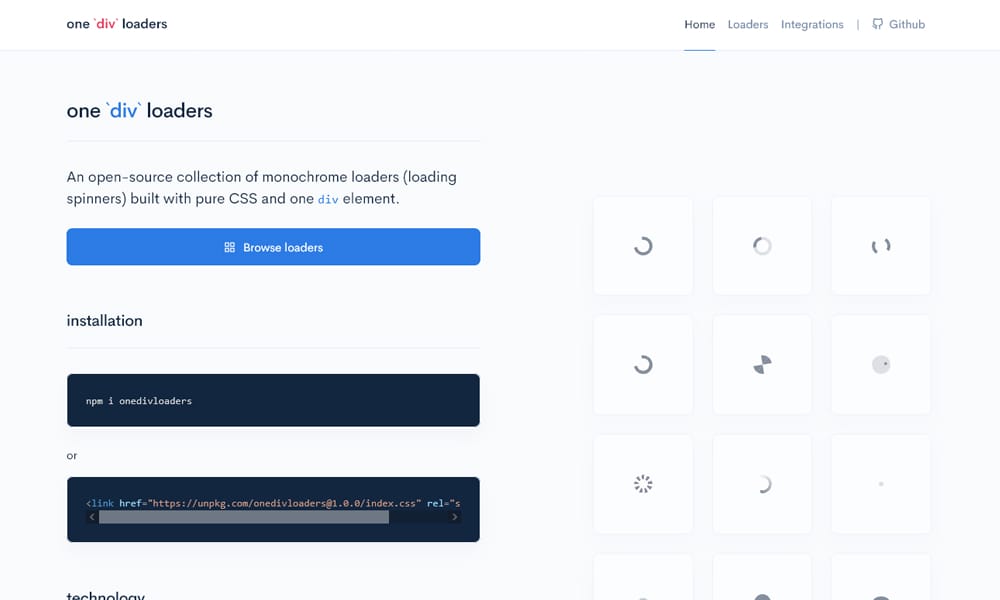
One Div Loaders is the “framework-aware” single-element spinner solution. Available as both pure CSS and React components with TypeScript support. npm package, Vercel-hosted demo, October 2024 maintenance showing active development. Perfect for framework developers who don’t want to wrap CSS in components manually.
Key Features:
- Pure CSS single-element spinners (no nested markup)
- React component wrappers with full TypeScript support
- npm package (
npm install onedivloaders) for easy integration - Vercel-hosted demo with fast loading
- Framework-agnostic CSS (use with Vue, Svelte, Astro too)
Best For: React developers; TypeScript projects; teams wanting to avoid manual wrapper components; modern frontend stacks; developers prioritizing DX (developer experience).
Cost: Free (open-source)
Main Limitation: Smaller collection than CSS Loaders (prioritizes quality and framework compatibility over sheer quantity).
Pro Tip: Install and import: import { Spinner } from 'onedivloaders'. Use directly: <Spinner variant="circle" />. No wrapper code needed; TypeScript types included.
CSSFX – Full CSS Effects Toolkit

CSSFX is Netlify’s broader CSS effects library that includes spinners alongside transitions, hovers, and other interactive effects. It’s not just spinners, but spinners are a stellar part of it. Click any effect, copy the CSS, done. No customization UI, but that’s kind of the point—simplicity and speed.
Key Features:
- Click-to-copy CSS effects (including spinners)
- Broader toolkit: hovers, transitions, reveals, animations
- Minimalist interface (no overwhelming customization UI)
- Netlify hosting (fast, reliable CDN)
- Syntax-highlighted code blocks for immediate comprehension
Best For: Developers wanting a one-stop CSS effect library; teams who like simplicity over customization; anyone exploring what’s possible with pure CSS; quick prototyping.
Cost: Free
Main Limitation: Fewer spinner-specific options than dedicated spinner tools (it’s a generalist effects library, not specialized).
Pro Tip: Bookmark CSSFX for any CSS effect project. It’s like “Easing Functions” but for modern animations—always useful.
SpinBolt – Trendy 2025 Aesthetics
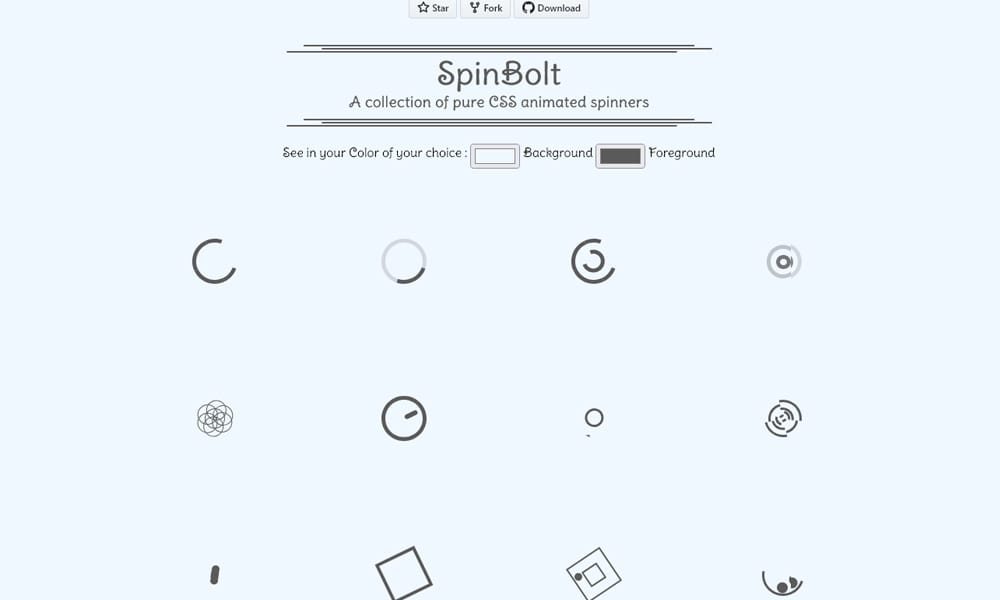
SpinBolt by metajunaid is a GitHub Pages collection focused on contemporary spinner aesthetics. Think 2020s design trends: subtle curves, muted colors, refined motion. If CSS Loaders is the “everything” approach, SpinBolt is the “curated for 2025” approach.
Key Features:
- Modern, trendy designs aligned with 2025 design trends
- Clean, minimalist aesthetics (no 2015-style overdone effects)
- Copy-paste HTML + CSS (fork to customize)
- GitHub repo with live demos
- Responsive by default
Best For: Startups and modern brands; projects avoiding dated aesthetics; designers who follow current trends; SaaS products; companies wanting contemporary, professional vibes.
Cost: Free (open-source)
Main Limitation: Smaller collection than mega-projects; design philosophy means it’s not for everyone.
Pro Tip: If you’re building a SaaS product in 2025, SpinBolt’s aesthetic will feel more native to modern interfaces than SpinKit’s 2015 designs.
CSS3 Loader – Learning-Focused Code

Fareco’s CSS3 Loader project is an educational resource disguised as a spinner collection. Each animation is thoroughly commented on, explaining why certain CSS properties work together. Perfect for developers who want to understand the fundamentals, not just copy code.
Key Features:
- Well-commented code (learning is the focus)
- CSS3 animation concepts explained inline
- Multiple loader patterns with explanations
- GitHub repository with active maintenance
- Perfect resource for teaching or self-learning
Best For: Junior developers learning CSS animations; educators and trainers; anyone wanting to understand how, not just what; mentorship or code review contexts.
Cost: Free (open-source)
Main Limitation: Smaller collection (prioritizes education over variety by design).
Pro Tip: If you’re new to CSS animations, study this code. The comments are worth more than the spinners themselves—you’ll level up faster.
LoadLab – Customizable Templates
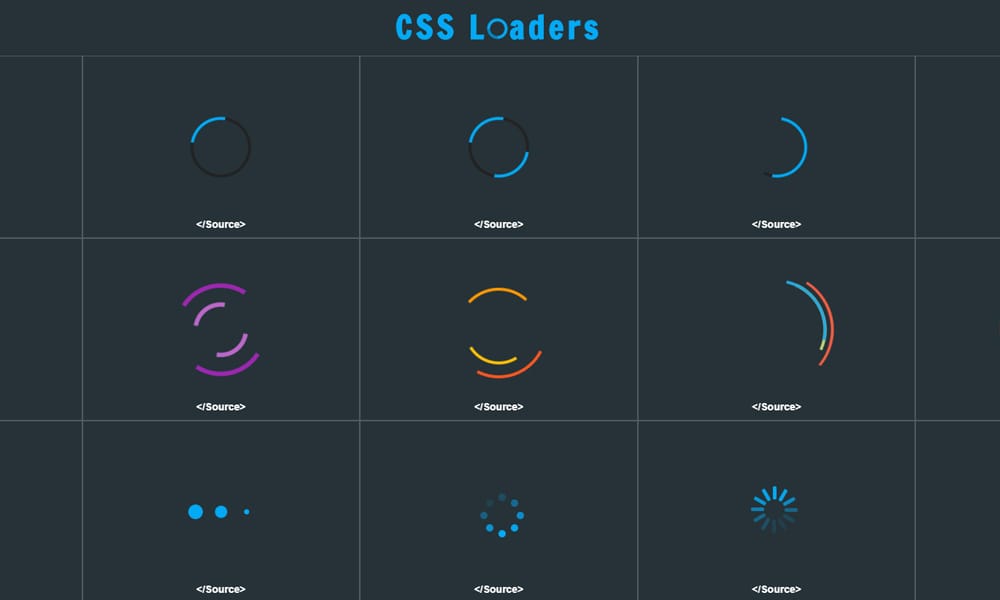
LoadLab by CamdenFoucht is an experimentation playground. The GitHub repo includes customizable loader templates that you can fork and modify for your specific needs. Less of a “finished product” and more of a “here’s the foundation for your custom spinner.”
Key Features:
- Customizable loader templates as starting points
- Well-structured CSS for easy modification
- GitHub repo encouraging forks and team customization
- Educational code comments
- Active maintenance
Best For: Teams building custom spinners; developers wanting a template to start from; projects needing unique, branded animations; companies standardizing spinners across products.
Cost: Free (open-source)
Main Limitation: Not a “grab and go” collection; requires customization and team setup.
Pro Tip: Fork LoadLab and use it as your team’s custom spinner toolkit. Every project gets unique branding without reinventing the wheel.
CSS Loading Animation – Beyond Spinners
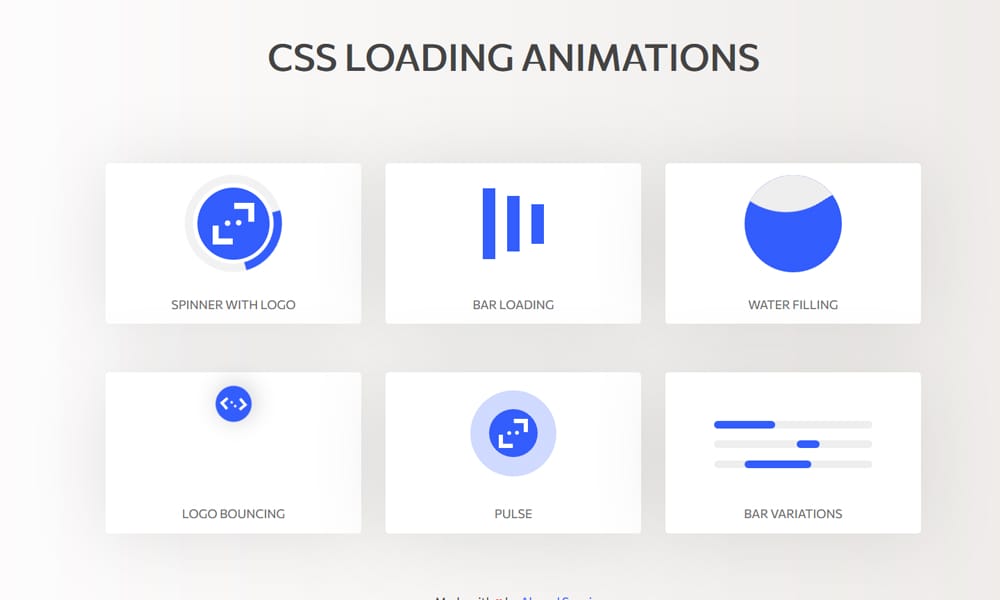
CSS Loading Animation (zuramai/css-loadings) is a GitHub collection featuring multiple loading animation patterns beyond traditional spinners—progress bars, skeleton screens, and transitional animations. Broader scope than pure spinners, but each animation is copy-paste ready and production-tested.
Key Features:
- Multiple loading animation types (spinners, bars, skeletons, pulse effects)
- Copy-paste CSS + HTML
- Active GitHub repository with recent maintenance
- Well-organized by animation type and use case
- Responsive-ready defaults
Best For: Developers wanting loading animations beyond spinners; projects needing progress indicators; teams building comprehensive loading state UI systems; comprehensive page loading experiences.
Cost: Free (open-source)
Main Limitation: Broader focus means fewer pure spinners specifically; more of a “loading states system” than a spinner collection.
Pro Tip: Combine CSS Loading Animation with spinners from other tools to build a complete loading state UI system (spinner + progress bar + skeleton screens).
The Spinner (CodePen) — Single, Polished Design
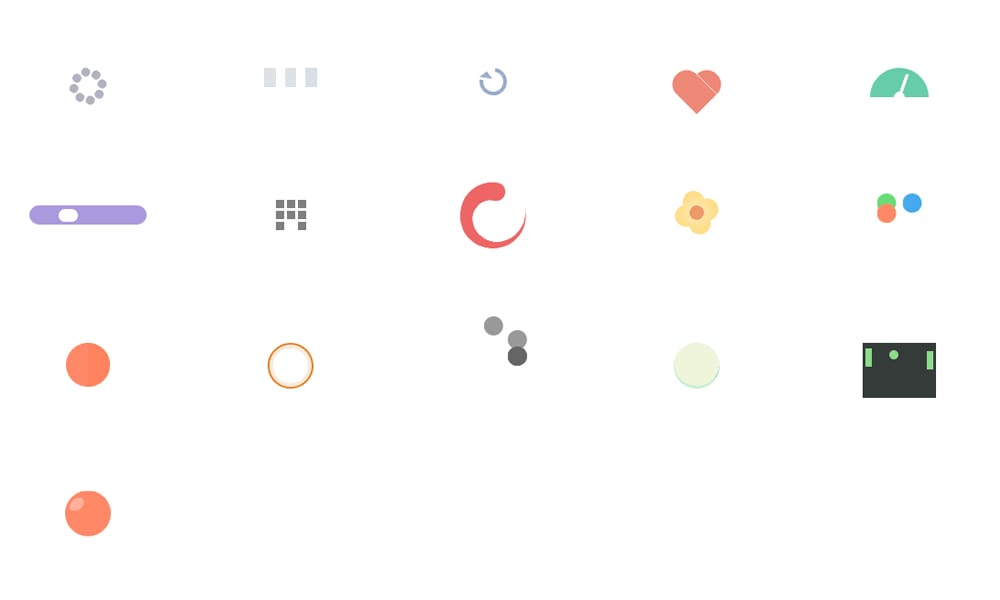
The Spinner on CodePen is a single, beautifully-crafted loading animation by Iulius90. Not a collection, not a library—just one well-executed spinner that you can fork and modify. Great for studying, tweaking, or using directly.
Key Features:
- Single, polished spinner design
- Live, editable CodePen environment
- Comments explaining the animation logic
- Fork-friendly (make your own version instantly)
- Shareable and embeddable in other projects
Best For: Learning from well-crafted code; projects needing one specific aesthetic; CodePen portfolio examples; studying animation techniques in action.
Cost: Free
Main Limitation: Single spinner (not a collection); you’re on your own if you want alternatives.
Pro Tip: Fork this CodePen and modify the colors to match your brand. CodePen handles all the previewing for you—see changes in real-time.
Loaders for Website (CodePen) — Real Context
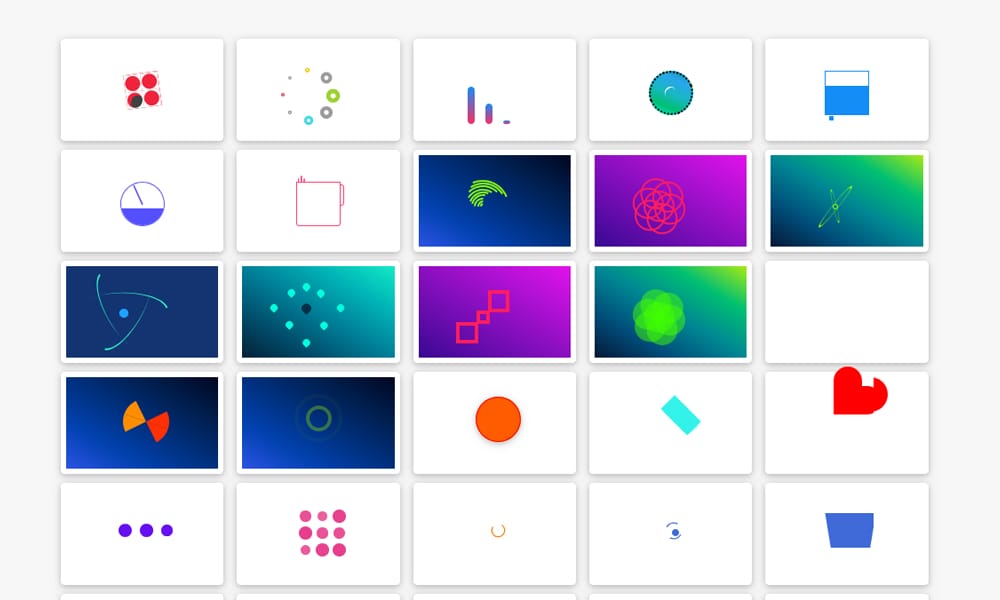
Loaders for Website on CodePen by uiswarup shows spinners integrated into actual website mockups—not just spinners on blank backgrounds, but spinners on hero sections, in modals, on form submissions. Realistic context changes everything about how spinners feel and perform.
Key Features:
- Multiple loaders shown in website context
- HTML structure showing real markup integration
- CSS + JavaScript interaction examples
- Live CodePen editing for experimentation
- Realistic use-case scenarios
Best For: Designers checking if spinners work in context; developers learning integration patterns; teams needing before/after mockups; visual verification before implementation.
Cost: Free
Main Limitation: Fewer total spinners than dedicated collections (but more realistic context).
Pro Tip: Before you finalize a spinner choice, fork this and swap in your candidate spinner to see how it looks on an actual page layout. Context changes perception drastically.
Pure CSS3 Preloaders (CodePen) — Educational Breakdown

Pure CSS3 Preloaders by mrsahar on CodePen is a tutorial-in-action. Each preloader is commented with educational notes about the CSS techniques used. Great for learning, tweaking, and understanding the fundamentals without external tutorials.
Key Features:
- Multiple pure CSS3 preloaders
- Educational inline comments
- Live editing environment
- Step-by-step code breakdowns
- Perfect for learning and teaching
Best For: Developers learning CSS animation; anyone wanting commented examples; educational resources; code review contexts; mentoring junior developers.
Cost: Free
Main Limitation: Smaller collection; focused on education, not comprehensive variety.
Pro Tip: Study these in CodePen’s editor. The code comments are tutorials you won’t find in most blogs—pure learning value.
CSS Loading Spinners (CodePen) — Quick Reference
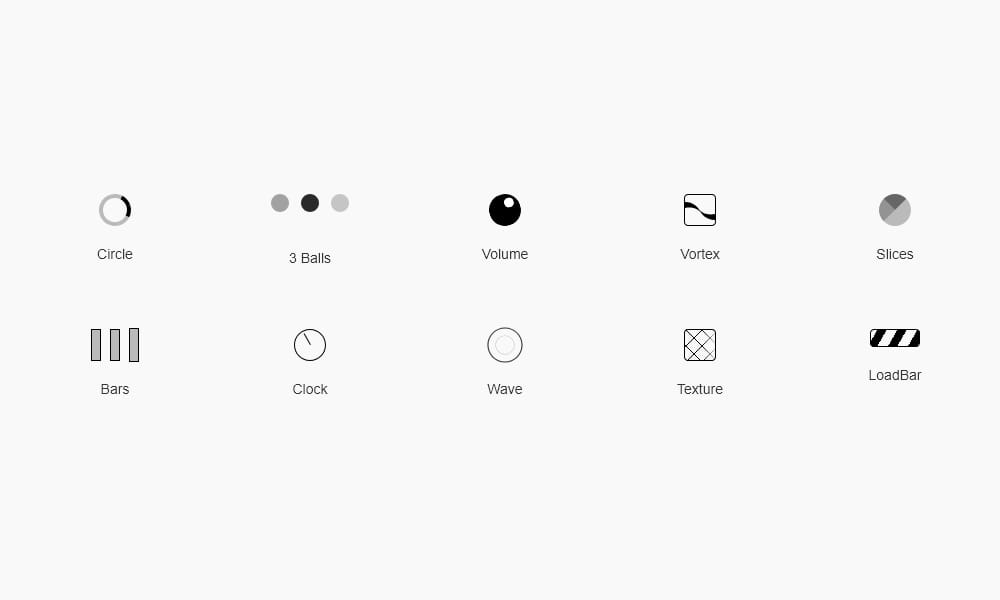
CSS Loading Spinners by bernethe on CodePen is a straightforward collection of spinners—no philosophy, just code. Fork it, copy it, modify it, done. Perfect for the developer who just needs a spinner and doesn’t want to think about it.
Key Features:
- Multiple spinner variations
- Copy-paste ready CSS
- Live preview in CodePen
- Easy to fork and modify
- Zero barrier to entry
Best For: Developers in a hurry; projects needing quick implementations; anyone avoiding analysis paralysis; rapid prototyping.
Cost: Free
Main Limitation: No customization UI; you edit CSS manually if you want variations.
Pro Tip: If you’re on a deadline, grab one of these, paste it, and move on. Sometimes done is better than perfect.
Quick Decision Guide: Choose Your Spinner in 60 Seconds
If you want the most variety: CSS Loaders (600+) or CSS Loader Generator (310+)
If you want proven, industry-standard: SpinKit (8 iconic designs trusted by millions) or Loaders.css (10.3k GitHub stars)
If you want performance above all else: Single Element CSS Spinners or Loaders Kit (single-element CSS only)
If you want framework integration: CSS Wand (React), One Div Loaders (React + TypeScript), Whirl (multi-format export)
If you want learning resources: CSS3 Loader or CSS Loader (well-commented code)
If you want trending aesthetics: SpinBolt or Whirl (2025-forward designs)
If you want customization UI: Loader, CSS Loader Generator, or Pure CSS Loaders (visual customizers)
If you want community and support: Load Awesome (active community) or Loaders.css (10.3k stars prove quality)
If you want text animations: Text Spinners (unique, character-based)
If you want dot-only patterns: Three Dots (50+ dot variations)
If you want educational foundation: Simple CSS Spinners or LoadLab (templates to build on)
Performance Best Practices: Why Some Spinners Are Faster
Not all CSS spinners perform equally. Here’s what separates A-Tier (60fps, smooth) from C-Tier (frame drops, battery drain):
Rule 1: Animate Only Transform + Opacity
These properties are GPU-accelerated and bypass layout recalculations. Animating width, height, left, top forces the browser to recalculate the layout on every frame—jank city.
Good (GPU-accelerated):
css
@keyframes spin {
0% { transform: rotate(0deg); }
100% { transform: rotate(360deg); }
}
Bad (CPU-intensive, causes jank):
css
@keyframes spin {
0% { left: 0; }
50% { left: 50px; }
100% { left: 0; }
}
Rule 2: Use will-change Sparingly
will-change: transform; tells the browser to prepare for animation, but overuse it wastes memory. Use it for your main spinner, not every animated element.
css
.spinner {
will-change: transform; /* One spinner, not all elements */
animation: spin 1s linear infinite;
}
Rule 3: Keep Animations Under 500ms
Perceived load time is psychology; a 300ms animation feels faster than reality. Studies show users perceive 200–500ms animations as intentional, not stalled.
Best duration: 300–1000ms (sweet spot is 600–800ms for smooth, intentional feel)
Rule 4: Test on Mobile Real Hardware
Your desktop might handle 60 FPS spinners fine, but a 2-year-old mid-range Android? Different story. Use Chrome DevTools Performance panel to audit.
- Open Chrome DevTools (F12)
- Go to Performance tab
- Record while spinner animates
- Check frame rate (should be 60 FPS; drops below 30 FPS = jank)
Rule 5: Avoid Full-Spinner Opacity Fades
Using opacity: 0 to 1 on the whole spinner causes repaints. Use opacity only for sub-elements (dots, lines).
Good:
css
@keyframes pulse {
0%, 100% { opacity: 0.3; } /* Dot pulses */
50% { opacity: 1; }
}
Avoid:
css
@keyframes fadeSpinner {
0%, 100% { opacity: 0; } /* Whole spinner disappears */
50% { opacity: 1; }
}
Performance Tiers (A/B/C):
A-Tier (Best Performance): SpinKit, Single Element CSS Spinners, Loaders Kit
- Use
transformonly - GPU-accelerated
- <2KB CSS each
- 60 FPS on mobile
B-Tier (Good Performance): Loaders.css, CSS Wand, Whirl
- Mix
transformwithminimalopacity - Mostly GPU-accelerated
- 2–5KB CSS
- 45–60 FPS on mobile
C-Tier (Performance-Conscious): CSS Loader Generator, Load Awesome (some options)
- May animate multiple properties
- CPU-intensive on mobile
- 5–15KB CSS
- 30–45 FPS on mobile (acceptable, but noticeable)
Integrating CSS Spinners Into React: Copy-Paste Guide
If you’re using React, here’s how to use any of these spinners without library bloat:
Option 1: CSS File Import (SpinKit, CSS Loaders, Loaders.css)
jsx
// Import CSS from your spinner source
import './Spinner.css';
export function LoadingScreen() {
return (
<div className="loading-container">
{/* HTML structure from your chosen spinner */}
<div className="spinner">
{/* Specific HTML depends on spinner choice */}
</div>
</div>
);
}
Option 2: CSS-in-JS (Styled Components or Emotion)
jsx
import styled, { keyframes } from ‘styled-components’;
const spin = keyframes`
0% { transform: rotate(0deg); }
100% { transform: rotate(360deg); }
`;
const StyledSpinner = styled.div`
width: 40px;
height: 40px;
border: 4px solid #f3f3f3;
border-top: 4px solid #3498db;
border-radius: 50%;
animation: ${spin} 1s linear infinite;
`;
export function LoadingScreen() {
return (
<div className="loading-container">
<StyledSpinner />
</div>
);
}
Option 3: Direct Component (CSS Wand, One Div Loaders)
jsx
// Best for team design systems
import { Spinner } from 'onedivloaders';
export function LoadingScreen() {
return (
<div className="loading-container">
<Spinner
variant="circle"
speed="fast"
color="#3498db"
/>
</div>
);
}
Option 4: Tailwind CSS Integration
jsx
export function LoadingScreen() {
return (
<div className="flex items-center justify-center h-screen bg-white">
{/* Paste spinner HTML here, wrap in Tailwind classes */}
<div className="animate-spin">
<div className="h-12 w-12 rounded-full border-4 border-gray-200 border-t-blue-500"></div>
</div>
</div>
);
}
Pro Tip: For most React projects, Option 2 (CSS-in-JS) is best because it:
- Keeps CSS scoped to the component
- Allows dynamic props (color, speed, size)
- Works with CSS-in-JS libraries most teams already use
- Avoids CSS file management
Accessibility: Making Spinners Inclusive
CSS spinners are visual; screen readers don’t see them. Here’s how to make yours accessible:
Step 1: Add ARIA Attributes
xml
<!-- Tell screen readers what's happening -->
<div
class="spinner"
role="progressbar"
aria-label="Loading content"
aria-busy="true"
>
<!-- Your spinner HTML -->
</div>
Step 2: Respect prefers-reduced-motion
This is critical. Roughly 26% of users have motion sensitivity (vestibular disorders, migraines, photophobia). Respecting preferred-reduced-motion prevents user discomfort and is a WCAG accessibility standard.
css
/* Default: animated spinner */
.spinner {
animation: spin 1s linear infinite;
}
/* Reduced motion: stop animating, show static indicator */
@media (prefers-reduced-motion: reduce) {
.spinner {
animation: none;
opacity: 0.6; /* Show it's still loading, just not spinning */
}
}
Step 3: Complete Accessible Example
jsx
export function AccessibleSpinner() {
return (
<div
className="spinner"
role="progressbar"
aria-label="Loading page content"
aria-busy="true"
aria-valuenow={33}
aria-valuemin={0}
aria-valuemax={100}
>
<style>{`
.spinner {
width: 40px;
height: 40px;
border: 4px solid #f3f3f3;
border-top: 4px solid #3498db;
border-radius: 50%;
animation: spin 1s linear infinite;
}
@keyframes spin {
0% { transform: rotate(0deg); }
100% { transform: rotate(360deg); }
}
@media (prefers-reduced-motion: reduce) {
.spinner {
animation: none;
opacity: 0.6;
}
}
`}</style>
</div>
);
}
Step 4: Test Accessibility
- Enable reduced motion on your device:
- macOS: System Preferences > Accessibility > Display > Reduce Motion
- Windows: Settings > Ease of Access > Display > Show animations
- iOS/Android: Settings > Accessibility > Motion/Animations > Reduce Motion
- Test with screen readers:
- Install NVDA (Windows, free) or use VoiceOver (macOS, built-in)
- Your spinner should announce: “Loading content, progress bar”
- Your spinner should:
- Stop animating when
prefers-reduced-motionis enabled - Announce loading status to screen readers
- Remain visible (don’t hide) even in reduced-motion mode
- Stop animating when
Common Mistakes to Avoid
Mistake 1: Animating Too Many Properties at Once
You don’t need transform, opacity, shadow, and blur all animating. Choose one or two. Less is faster.
css
/* Bad: Too much animating */
@keyframes overkill {
0% { transform: scale(1); opacity: 1; filter: blur(0px); box-shadow: 0 0 0 0 rgba(0,0,0,0.3); }
50% { transform: scale(1.2); opacity: 0.8; filter: blur(2px); box-shadow: 0 0 20px 10px rgba(0,0,0,0.5); }
100% { transform: scale(1); opacity: 1; filter: blur(0px); box-shadow: 0 0 0 0 rgba(0,0,0,0.3); }
}
/* Good: Focus on one or two properties */
@keyframes efficient {
0% { transform: rotate(0deg); }
100% { transform: rotate(360deg); }
}
Mistake 2: Using GIFs Because You Don’t Understand CSS
A 50KB GIF spinner will load slower than 100 pure CSS spinners combined. Learn CSS; your users will thank you with faster load times.
Mistake 3: Not Testing on Mobile
Your spinner looks great at 1920×1080. At 320×480? Frame drops, battery drain, user frustration. Always test.
Mistake 4: Forgetting Responsive Sizes
Your spinner looks perfect at 1920×1080. At mobile? Huge and intrusive. Use viewport-relative sizing.
css
/* Good: Scales with viewport */
.spinner {
width: min(10vw, 50px);
height: min(10vw, 50px);
}
/* Bad: Fixed size */
.spinner {
width: 50px;
height: 50px;
}
Mistake 5: Not Respecting prefers-reduced-motion
Accessibility isn’t optional. Implement it or your spinners will cause user discomfort. WCAG 2.1 Level AA requires it.
Mistake 6: Spinning Without Purpose
If content loads in 0.2 seconds, don’t show a spinner. You’ll frustrate users with false loading states. Show spinners only when load time is likely >1 second.
jsx
// Only show spinner if loading takes >1 second
const [showSpinner, setShowSpinner] = useState(false);
useEffect(() => {
const timer = setTimeout(() => setShowSpinner(true), 1000);
return () => clearTimeout(timer);
}, []);
FAQ: CSS Spinners Questions Answered
Q: Should I use CSS spinners or SVG animations?
A: CSS spinners are smaller and simpler for basic shapes (circles, dots, bars). SVG is better for complex, custom illustrations (logos, mascots). For 95% of projects needing simple loading indicators, CSS is the right choice.
Q: Will CSS spinners work in IE 11?
A: Some will (depending on the spinner), but most won’t. IE 11 support is dead; don’t optimize for it. If you absolutely must support IE 11, use a GIF fallback spinner.
Q: Can I use CSS spinners in email?
A: No. Email clients don’t support CSS animations. Use a GIF spinner for email campaigns; CSS spinners for web.
Q: How do I customize a spinner’s color?
A: Find the background-color, border-color, or color property in the CSS and change it. Most spinners use CSS variables (e.g., --spinner-color: #3498db😉 for easy customization.
Q: What’s the best performance spinner?
A: SpinKit or Single Element CSS Spinners. Both use only transform and opacity, the GPU-accelerated properties that guarantee 60 FPS on mobile.
Q: Do CSS spinners work offline?
A: Yes, they’re pure CSS. No external resources, no API calls, no dependencies. They work offline by definition.
Q: Can I use the same spinner across multiple projects?
A: Absolutely. Most of these tools are open-source (MIT license). Copy the CSS, paste it into your project, customize as needed. Commercial use is allowed.
Q: How do I make a custom spinner for my brand?
A: Start with CSS Loader Generator or Loader (real-time customization), tweak colors to match your brand, export CSS, done. If you want something unique, fork LoadLab or Simple CSS Spinners and modify the keyframes.
Q: Which spinner should I use for a mobile app?
A: Three Dots or Single Element CSS Spinners. Both are small, lightweight, and perform well on mobile. Avoid spinners with complex animations or large CSS files.
Conclusion: Start Spinning Today
You’ve got 31 tools, from single-element minimalists (Loaders Kit) to mega-collections (CSS Loaders), from learning resources (CSS3 Loader) to production standards (SpinKit and Loaders.css). Every project is different, but every project has a spinner that fits.
Here’s what to do next:
- Pick one tool from the decision guide based on your use case
- Copy the HTML and CSS from your chosen spinner
- Paste it into your project
- Customize the color if needed (usually one CSS property)
- Add ARIA labels for accessibility
- Test on mobile to confirm smooth animation
- Ship it
That’s it. Done. Your users see a spinner, not a blank screen, and you’ve shipped in under 10 minutes.
All 31 of these tools are free and maintained as of November 2025. No signup, no credit card, no “free trial” nonsense. Pick one and ship. Your loading states will never be boring again.

